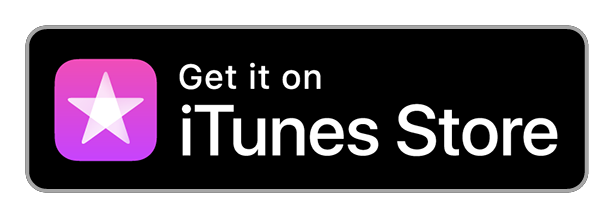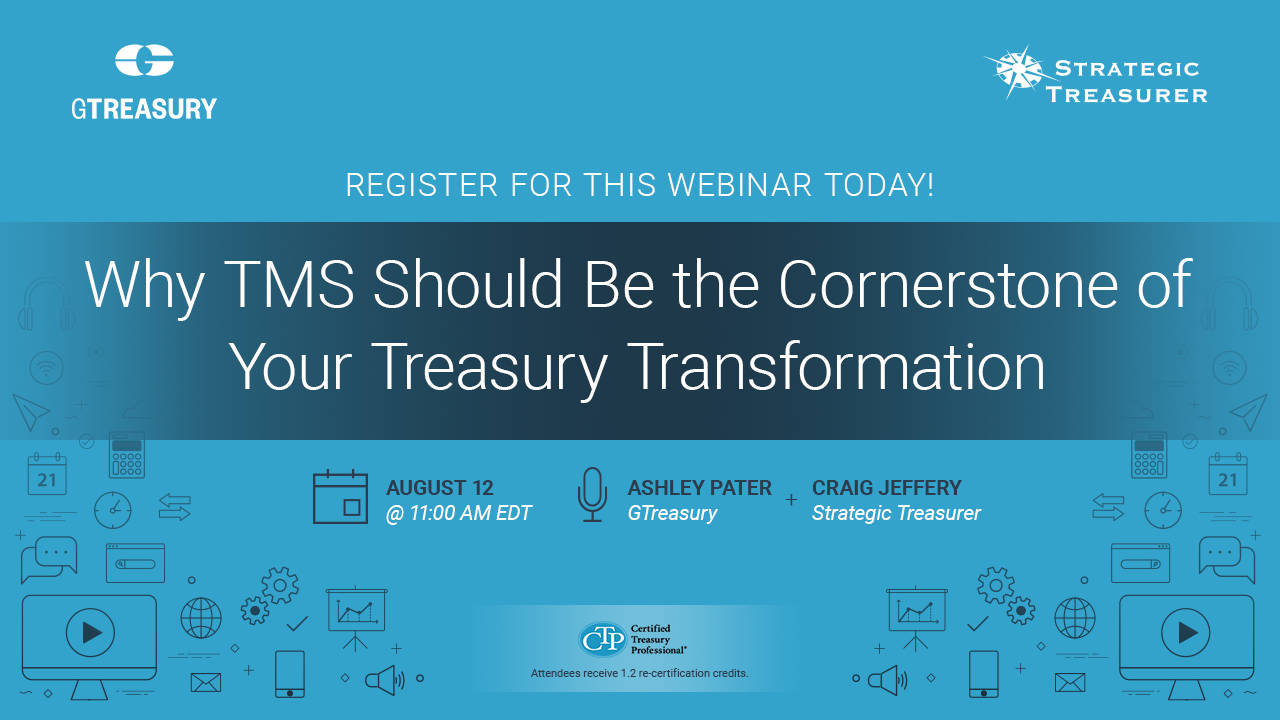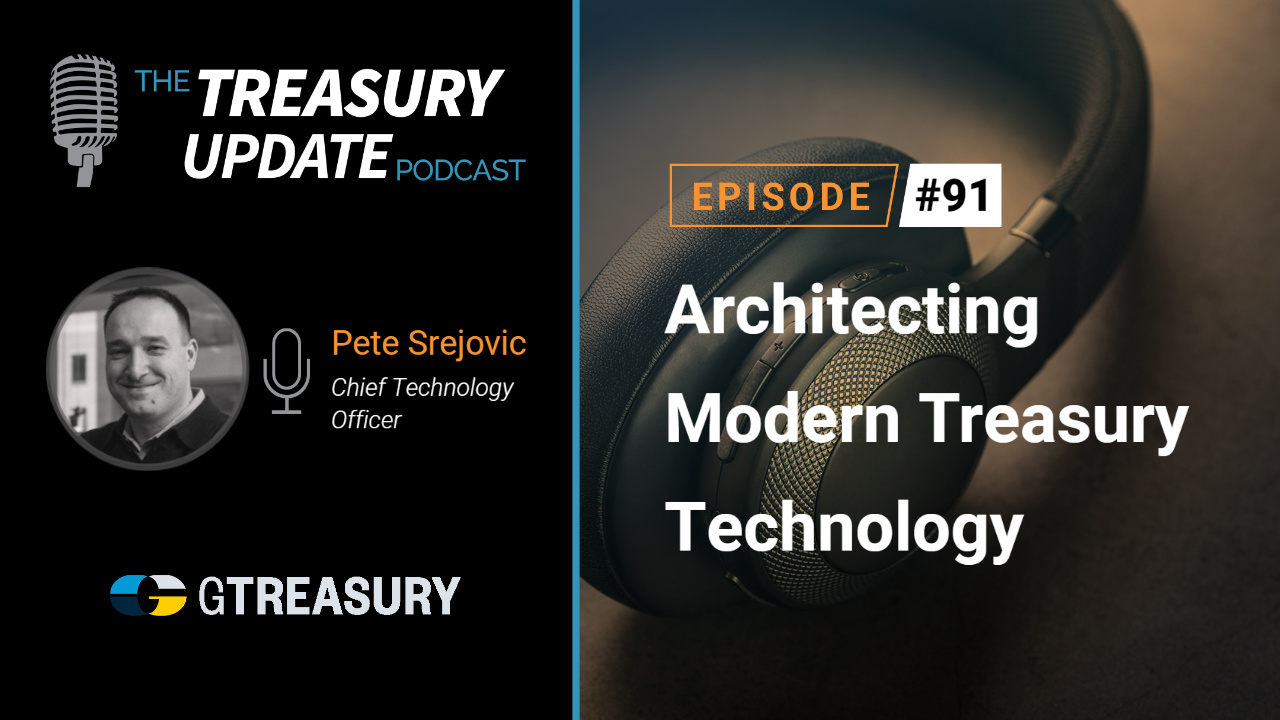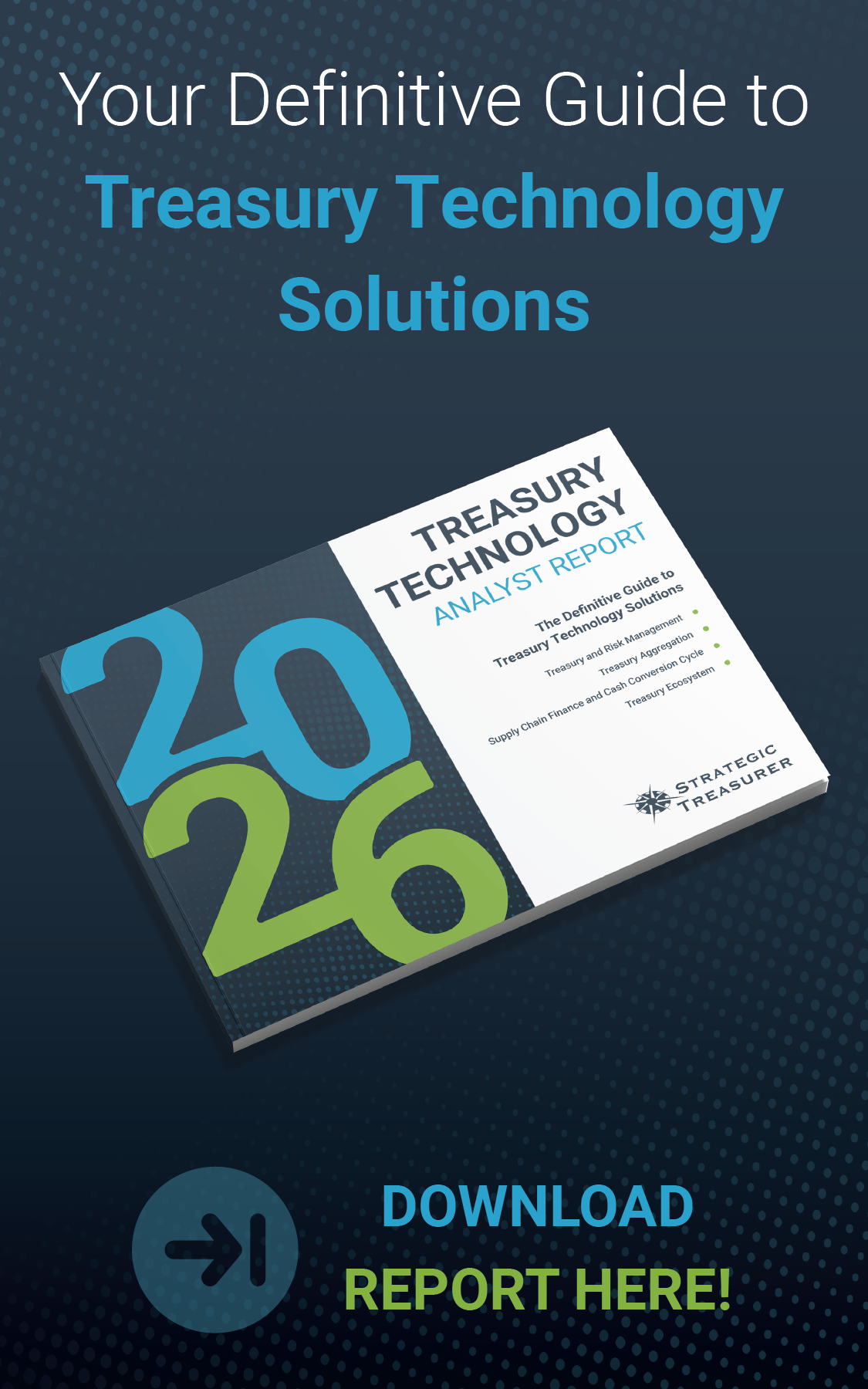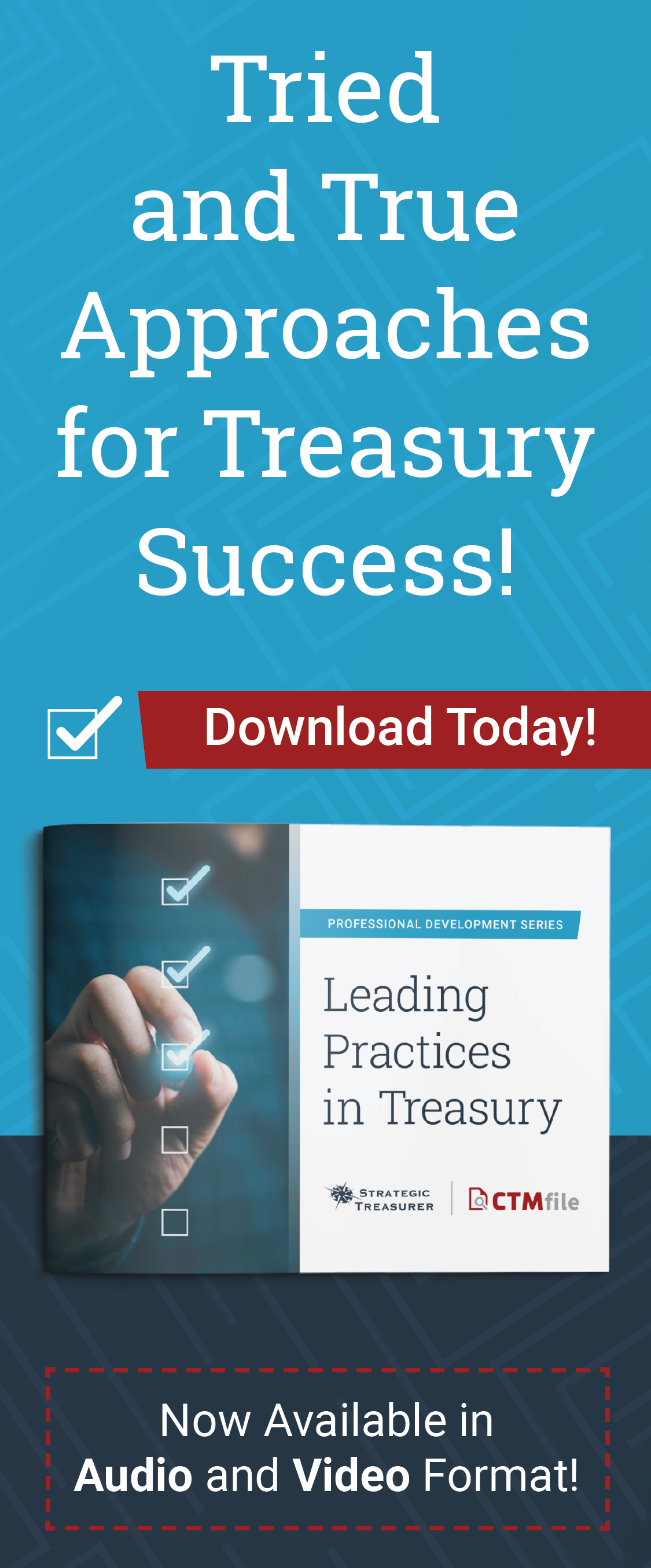
Episode 167
Why TMS Should Be the Cornerstone of Your Treasury Transformation
Host Craig Jeffery joins Ashley Pater, Chief Product Officer at GTreasury, to cover questions from their webinar on why a treasury management system (TMS) should be the cornerstone of your treasury transformation. They share valuable insights and examples on how to transition treasury operations to a modern and efficient technology stack, complete with automation and integration that allow organizations to focus on strategic tasks. Listen to find out more.
Host:
Craig Jeffery, Strategic Treasurer


Speaker:
Ashley Pater, GTreasury


Subscribe to the Treasury Update Podcast on your favorite app!
Episode Transcription - Episode #167: TMS Should be Cornerstone of Treasury Information
INTRO 0:07
Welcome to The Treasury Update Podcast presented by Strategic Treasurer, your source for interesting treasury, news, analysis, and insights in your car at the gym, or wherever you decide to tune in. On this episode of the podcast host Craig Jeffrey joins Ashley Pater, Chief Product Officer at GTreasury, to cover questions from their webinar on why a treasury management system should be the cornerstone of your treasury transformation. They share valuable insights and examples on how to transition treasury operations to a modern and efficient technology stack, complete with automation and integration that allows organizations to focus on strategic tasks. Listen in to find out more.
Craig Jeffery 0:56
Welcome to The Treasure Update Podcasts, Ashley.
Ashley Pater 0:59
Thanks Craig, excited to be here today.
Craig Jeffery 1:02
We had a good time on that webinar where we talked about why a TMS should be the cornerstone of your treasure transformation and it is fun when there’s an overflow of questions and we had promised to respond to those questions, and we could have either done it in writing or with a podcast, so we’ve done it with a podcast. So, I’m excited to have this discussion and to talk through these items, but let’s begin. One of the questions that came in, and I’ll start it, and we can both talk about in terms of API’s and the number of records that can be processed at what point do you recommend a file-based process versus an API based process? I want to set that up a little bit, well maybe we should talk about that at first, is we were talking about making connections, and then there’s historical file-based process route, and I think we also talked about scaling or capacity issues there. But is there a break point where you say, let’s go from API to file based or vice versa?
Ashley Pater 2:00
You know one of the things we talked about on the webinar was everybody’s going to be moving more towards this API based architecture at some point. Right now, SFTP unfortunately probably won’t go anywhere overnight. You know while it’s legacy it’s definitely going to stick around for a bit, but I think as we start to see more API’s become available I think it’s important to start to think about how you’re going to adopt it within your organization and there’s a couple ways to think about that right? One volume isn’t the only driver, it may be for specific API’s if you’re looking at things from a payment standpoint or what have you. There may be some immediate performance benefits there, but I think overall, you know the key benefit of the API there isn’t necessarily a key threshold that I would suggest at this stage. I think it’s something you’re going to have to do eventually anyway it’s just where you are at in your journey as an organization and probably where your financial institutions are or your ERP’s or what have you. That’ll also drive that as well. You know, the key thing with API’s that’s a benefit, aside from, you know, volume, performance and things of that nature is also some more simplicity of it right? So, how quickly you can onboard some of these things and, you know connectivity is probably one of the things that takes the longest time during an implementation, whether that is balanced reporting or payments or what have you, API’s can reduce that onboarding drastically. So, you’re looking, you know, instead of four to six weeks you’re doing things in minutes or hours. There’s that user self-sufficiency aspect as well where, you know there isn’t so much dependency on the TMS provider or the bank where you as a user can help set these API’s up with that self-sufficient onboarding as well. So, I think, you know, it’s a long-winded way to say I don’t think volume should be the only driver. I don’t think it is the only driver, I think you’re gonna have to move to these API based solutions anyway, so wherever your organization is on that journey and kind of thinking about being an early adopter and some of these I think has a lot of benefits.
Craig Jeffery 4:05
That’s a really useful discussion because it’s where things are heading. Thinking back to the last trend. The last major transition between how large files were delivered they were, they were oftentimes delivered by tape. This was a physical device that people would drive to the bank, this was a long time ago, and you couldn’t transmit it because the transmission speeds were very slow and unless you paid for a dedicated circuit from your company to the bank, you might not be able to transmit at a time within the timeframe that would exist before it would timeout. And so, there was tape deliver, as speed improve, you got rid of the old tape deliveries and we would do some type of file transfer, with the example here. I think the same thing has happened but, but very quickly on the API side where initially you set things up there might be some latency issues or timeouts are set but those get tuned, or those have been tuned with early banks extraordinarily quickly. I mean I think that’s been your experience.
Ashley Pater 5:07
Yeah, and I think that’s the great thing about you can make those updates relatively quickly and you can be agile and react as well, you know, right now, I don’t know how long it’ll last, but right now there’s also a lot of cost benefits so starting to leverage API’s. And I think that’s another benefit as well like thinking of things from a bank perspective or starting to see that with some of our early adopters of our bank API so it’s another component but the performance aspect, and also you can determine that, right? You can determine how frequently you want to do those polls, how frequently you want, how truly real-time do you want it to be in some of these instances, which I think is another nice benefit but the performance and the ability to kind of pivot, adapt and make some of those changes as need be, whether it’s a new authentication process, that performance improvement, what have you, it’s a lot more efficient as well which I think from a technology standpoint is really exciting.
Craig Jeffery 6:03
The cost example, I want to spend a lot of time talking about, but I know we shouldn’t.
Ashley Pater 6:07
Probably a whole other podcast.
Craig Jeffery 6:10
Well, it’s interesting you know as this is people move to offering SWIFT and other methods sometimes, they were priced more highly and sometimes priced more lowly. I think one of the things that we’re like you’re seeing is there’s a, there’s a bit of a price benefit there. But I, I think that the longer game is that we’re going to get a lot more information more readily. The cost per something will go down, will stay lower, but people will pull a lot more information or banks will certainly price it so like, they can make their money, whichever method that connection is, and they should. But you bring up some really good points there. Now, shall we move on to another three-letter acronym.
Ashley Pater 6:52
Absolutely.
Craig Jeffery 6:54
So, one of the questions was can you provide examples of how RPA or robotic process automation and machine learning, you know, two different things are used in treasury departments? I don’t know if you want to start with that? Talking about bots or machine learning. I’ve got a few things to share as well.
Ashley Pater 7:11
Yeah, I’ll start with machine learning and then we can kind of wrap up on RPA as well. So, I think machine learning is something that’s going to come up more and more and you’re starting to see it be part of the initial framework and architecture within TMS’s as they start to build it out. I think it’s a matter of time for treasury and treasurers to get competent and truly leveraging machine learning, but you know we’re definitely starting to see the demand for this pop up. There’s a couple of key areas that are no brainers and we look at this application of machine learning as the evolution of intelligent treasury, right, like how do you continuously start to have your platform evolve from being a transactional based platform to more predictive analytics tool. Forecasting is probably the one everyone sees most common, you know, the ability to be able to auto detect variance analysis, provides system recommendations and where you can potentially perform better or forecast better. Another key candidate here is definitely within reconciliation, kind of starting to determine confidence thresholds where the system can auto reconcile for you. Hey, I feel 90% confident but I want to make sure the systems 97% confident before auto reconciles, so there’s some of those things and then fraud detection, you know “Hey you normally make this payment for $1.2 million at the quarter you scheduled it for 120,000. Are you sure that’s right?” So, I think those are some of the key ones you’re gonna start to see happening within TMS platforms. And now it’s just a matter of time is how do you get treasury departments confident with leveraging these tools to make those decisions. And that’s going to be a journey, right? Just like any new technology, with API’s back in the day too, we’re still talking about API’s they’re new technology, but it took time for people to get confident with those as well. So, I think you’ll start to see that evolution with machine learning.
On the RPA side you know I think there’s two portions right one, how does a TMS provider offer leverage and RPA but there’s also treasury departments that are using it completely separate from a TMS and that’s what we see a lot as well. Obviously within our organization and for you know onboarding of customers we leverage RPA, to do some of those, you know, static data tasks onboarding tasks within our own organization we leverage it in different ways whether it’s you know doing security and compliance or, you know, helping our services team or even from an onboarding perspective or internal processes within the product team, we have an internal bot that we use, Gee Whiz. He’s our go to guy. I know you always love talking about you as Craig but he’s, he’s critical to us, but I think we see a lot of our corporate clients also adopting this, whether it’s doing data management formatting on their side, account reconciliation, reporting liquidity and exposure management. So, there’s other ways they’re doing it outside of their TMS or within their own organization that I think is really fascinating to see as well.
Craig Jeffery 10:25
Yeah, I think the name Gee Whiz is pretty interesting, but you know you start anthropomorphizing this like this guy who does a lot of stuff and I just wonder what that’s going to do? But seriously, so you know on the, on the RPA side of robotic process automation we always, not always, but we typically think of companies and see companies using this to bridge the gap between systems. I need to go out and get something, check, validate, move it into another system separately. Now, I know we just spoke in the section before about API’s, if there’s an API that can handle that, you know checking validation loading, well you would certainly use that that would be almost always superior to, you know, an RPA or a bot that does it that you know bots can break if information flows differently or changes, but there’s a massive amount of data that has to be pulled, reviewed, loaded–things have to be checked and bots help us eliminate many, many of these tasks and so treasure groups are doing that. There’s some podcasts where we talk about where I interview people that are using RPA very heavily in treasury and in finance and are just saving massive amounts of time, huge number of hours, people years’ worth of events of activity, and this allows them to address many other functions. So, you know, you can always wait for almost forever to replace it with an API, you might really be able to realize some benefits and RPA side and a number of companies are doing that. You gave a lot of good examples with Ge Whiz, or your bot, it’s like, “Hey, I got a load a bunch of data? Why do I need to do all these steps? How come I can’t just use like an automated a great macro that takes stuff from one system and puts it in another real good, real good uses there?”
Now, I’m gonna mess up the order of these questions. Just for fun. One was a question how many respondents are in the fraud survey for example, but they’re asking about surveys and there’s over 330 respondents in that one but I actually I’m not sure if I have a question on this, there were other surveys that informed this particular webinar, and in our show notes we’ll put information about downloading those. There’s a treasury technology survey that was also done with GTreasury. We’ll have that in the show notes so you can download and get information on that, and there’s a cash forecast and visibility survey which I believe is active right now so the results will be coming soon. So, I know you and she GTreasury like data and many of our listeners do too so that’s that quick question I wanted to dispense with that one. And now we’ll move to another question, and this was a little different because it touched on AR and AP, which some don’t, don’t look at that as being within treasury transformation but the question was: Would you say most companies handle AP and AR solutions, via their bank’s treasury management platform, or are more company starting to use non FI service providers, I don’t know if you want to start on that or you want me too? How would you like to go?
Ashley Pater 13:50
Yeah, why don’t you take a stab at that, Craig, and I’ll chime in here.
Craig Jeffery 13:55
We do a lot of surveys and work with companies across the finance spectrum, so you know touches on the cash conversion cycle like AP/AR and treasury, of course, one element here is that, you know, AP and AR overtime, this is not massively, a massive shift but it is happening, but they’re converging more and more with treasury on working capital management, but also on payments. And so, we see this you know as the growth of payments, outbound and inbound, are happening that treasury is getting more involved there, and they’re working together. Treasury continues to take more of a leadership role and tends to have more groups reporting into them, at least for responsibilities for payments, and that various company by company but we’re seeing that. The other points, Ashley, that we think is really interesting is this end-to-end view that organizations are taking, and that includes AP and AR not just treasury. But AP is looking at how does this work in our organization, but also with the other organizations, AR side of the business so very very interesting that they’re saying, what we do impacts someone up and downstream, even outside organization I think that’s a mature view and that’s good progress. Finally, before we get to the discussion of why this might be the case. Growth, more companies are looking to tech firms then they have in the past. Most of the activity is with banks, but tech firms, continue to gain an increased share of the market, and more companies are looking at tech firms to help solve some of these solutions. They trust their banks tech firms are oftentimes, providing very comprehensive solutions or more impactful solutions, and then banks are partnering, white labeling, with those but maybe that gives us a chance to talk about why and what are you seeing.
Ashley Pater 15:52
There’s always going to be some healthy tension between finance and treasury, but we’re starting to see that like a natural convergence between the two, right? And you hit on one of the key areas that we see that a lot in which is which is payments, right, and focus more on having that centralized, end-to-end solution, extending the usage of a TMS to accommodate the finance side of the organization. And we touched on this a little bit in the webinar, you know, growing your ecosystem as well, right, that, you know, being able to connect to all the necessary third party data that you have and I think, because that is so critical, I mean you look at the surveys we’ve done with you guys but you know you look at some of the big four surveys or what have you like the criticality of, you know, having that robust ecosystem is so key as part of these projects that it naturally brings in that kind of AP/AR side of life as well. You know and I think that that’s a great thing to see. You want to have that centralized location; doesn’t mean you have to have one system, but it has one system that connects to the systems that you need right? And maybe you focus on a couple of those core functions where you really do want to have just, a one stop shop or a one system to do that. Maybe that’s payments, maybe that’s for your recording or what have you? But you know I think that we started to see the office of the CFO moving towards extending the TMS usage in this area and integrating a bit more. And I think that’s really exciting to see it’s exciting to see from an open architecture platform because that’s really key to a lot of our vendors and providers, and I think as we’ve talked more and more about API’s and having that data readily at your fingertips because the number one thing that each one of these areas wants is visibility. And they want visibility, and they want the ability to execute on those things quickly and have that full view and not always have to depend on one person or one team or another. And so, I think having that natural convergence is really exciting to see from our standpoint, and I’m excited for the opportunities it brings for us but also for our users as well.
Craig Jeffery 18:01
Right, so the next question or the last question: is Can the system, so it’s talking about treasury systems, can the system reconcile forecasts at balance and show where there are discrepancies in order to improve the forecast? You know, and that the question had some other things about do we do this manually so maybe broaden that discussion to, you know, beyond just kind of system reconcile forecasts and but to talk about broadly what’s needed to reconcile and how does this system help them?
Ashley Pater 18:37
Yeah, absolutely. And look, I, you hit on this earlier too, we have a survey going on right now, so it’ll be interesting to see how these kind of demands and interests and priorities shift as a result of this? But from the conversations we’ve had the surveys we’ve done in the past, the forecasting is still gonna be the number one thing everyone wants to do. The number one thing no one has time to do it. So, I think having a solution that can scale from the basics to the advanced scenarios is very key right? So, the reconciliation portion of forecasting is key and it’s kind of the next critical component aside from, “Hey how do I get all my data in a place, so I can forecast. Now I have it. Now how can I do my scenario variance analysis, which is a key component and then how can I kind of have that evolve and do the reconciliation process?” This is kind of the natural forecasting flow from basic, intermediate to advanced. So absolutely this is something that’s key within all TMS providers, it’s definitely something, as we talked earlier about too there’s some great opportunities for machine learning and AI to come into play as part of this as well. You know, intraday matching functionality is probably one of the most common areas we see for this on a reconciliation standpoint, and that absolutely can be automated, it can be manual if you prefer, it’s also up to the customer preference but, you know, the key here is to be able to match off the bank versus the back office data removing one side of the match and having that, you know, display on the reporting or worksheet or what have you that you want. So, it’s definitely a key component to that forecasting workflow, and then how you want to apply that to all your various scenarios and variances is also a key component as well.
Craig Jeffery 20:28
Two things I wanted to highlight from your answer you know this this idea that it’s been multiple years, that people are saying, “I need to spend more time on forecasts, and I would spend more time. I don’t do it as well as I should. You’ve kind of got to focus on that.” And, your point, tying that into your point about machine learning is we’re never going to get there just by throwing more people at it. We have to have tools that help. And like you said, machine learning can help with pattern detection, offer an ability to scale, a tool that helps us scale. I think the other part that’s at the core of the question, I’ll try to be brief on this is that you know what, what do we do with discrepancies? When we see discrepancies, there might be an element where the machine learning process helps us identify that, but as we see discrepancies in a forecast that can be a feedback loop where we learn. Oh, somebody didn’t report, very significant item, that’s a human communication issue. Oh, we’re spotting trends and changes, well maybe machine learning points that out, or we have a different mix of business, and we’ve got everything lumped into a broad category, so we don’t see how components of that are shifting. Maybe we need a different level of detail.
Ashley Pater 21:46
Yeah, and I think too, you know 2021 has been a more normal year compared to what we’ve had in the past, I wouldn’t say it’s the like definition of normal but if you look at 2020 things started to stabilize a little bit. So how does the 2020 impact your historical, you know, and your future forecasting as well, right? You know, I think that’s another, we saw a lot of customers having to do more frequent forecasts like everybody did last year, how that has transitioned to how you forecast in 2021 and beyond like is that now part of your DNA, do you still need to do weekly, daily, forecast versus your typical monthly, quarterly annual? So, I think it’s been interesting to watch. You’ll still have like I think we’ll still see a lot of the common drivers and things with forecasting, but I think how you think about forecasting, how that’s changed as a result of the pandemic, is also kind of interesting to see as well and for that you need to have those tools in order for that to be successful.
Craig Jeffery 22:49
Your point about the doing forecast more frequently, yep, we have certainly seen people running them more frequently. We’ve also seen them running more models, both of those create a stress point for very human centered forecasts that you know, people intensive forecast. So, I think those are, those are two good points that the expectation is more, and we need tech to roll that out. Now that brings us, Ashley, to our last set of questions. I group these two together, I’ll read them and then we can dialogue on these. So, these are questions about getting senior management buy in, front end cost or putting in TMS systems, this was part of the webinar, questions that we had from that. And so, what do you see from corporates is the biggest challenge in getting senior management buying to invest more in a TMS? The other question was: Are there any projections for the reduced front-end costs for installing TMS, treasury management systems? This seemingly has been the main roadblock from upper-level management teams. So, maybe you could begin the response there.
Ashley Pater 23:55
Yeah, absolutely. I think there’s a couple key things here. And I know there’s plenty, we could talk about kind of the key qualitative and quantitative value propositions for a TMS for I don’t know, probably multiple hours I would say. But here’s kind of a couple of the things that we’re seeing, the biggest thing that we find to be successful when trying to get buy in from senior management is being able to produce some tangible ROI as well right? By doing this, we’re going to see the results of x and one there’s some functionality where you can have a slam dunk on that right the easiest one is being fee analysis. So, I think if you’re looking for hard dollar amounts, it also depends on what your internal business objectives are, what’s the core driver here. I think there’s some, you know, financial ROI that will really resonate with your CFO, right? And I think we’ve done some stuff with you guys in the past to crag on ROI calculators and things of that nature. So, I think there’s some really great opportunities to be able to justify some of those hard dollar costs, but then also, if you’re going through a treasury transformation process as an organization, you know, here we’re going to be revamping X Y and Z processes and you know, we’ll see the benefits of that by implementing this TMS provider because of automation or what have you, there’s a lot of benefits like in order for your internal treasury transformation to be successful, you need to have this technology counterpart in order for that to have the impact that you want. The other portion of that question in regards to what about reducing front end costs for installing a TMS. Look, I think as we’ve seen the persona of the treasury department evolve, they want to be a bit more self-sufficient than I think we’ve seen in the past which is really exciting to see. So, how can the onboarding process be easier also impacts that? So, we started this podcast talking about APIs, so I’ll probably slightly finish it by talking about API’s, but that’s a great example of an area where you can reduce your time and reduce your costs by leveraging API’s for connectivity. There are things like having more of these workflow based implementations and self-service onboarding tools that are going to help that as well, so it’s definitely core to how TMS providers are starting to evolve how they build their products, and I think you’ll start to see that kind of happened more and more as time goes on.
Craig Jeffery 26:28
Yeah, and I think a couple of points that you made, or just to expand on or comment on, you know the historical view of how difficult things are. Each version of tech gets easier, faster, smoother. And if we’re looking at how we do things now versus 10 years, ago 20 years ago, and sometimes that’s the residual organizational memory, or the experience that people have and so it’s, it’s true, because in their head, but it’s also outdated and so this ability to adapt to, “What does it look like today?” How is that changing? What’s changing? How much is it changing? What’s not changing? And that can have a big influence on, “Oh, the cost to do something is less the time to realize the value is shorter, the pain and headaches are less”. I think that’s really important to make sure, when we’re going through those processes were bringing senior management along, making sure they understand what’s different and you know the time to value the overall strategic value to organization are ways that these can be removed. And that’s such a vital, vital aspect to helping your organization, you’ve got to be able to justify the tech, and the tools to make it work.
Ashley Pater 27:48
Yeah, and I think, you know, one of the things that has always been a recurring theme as we talk to treasury departments as you look at these surveys is, I want to be able to do more strategic based initiatives, and less day to day, you know, tactical tasks right? How do I get out of the weeds, and start to think about that and if you’re talking about that with your senior management I think that’s a huge portion to play towards. As you apply this technology you can do more of those things, you know, treasury is a huge strategic partner within organizations now. They have a seat at the table and it’s you know having a strategic outlook of that and being able to automate some of these tasks and start to be able to focus on those strategic initiatives for my treasury department point of view I think is really, really critical.
Craig Jeffery 28:45
Very good. Ashley, thank you so much for extending the conversation from the webinar, onto the podcast, really appreciate that your comments.
Ashley Pater 28:53
Yeah, thanks for the time, Craig, always a pleasure, appreciate it.
OUTRO 28:59
You’ve reached the end of another episode of The Treasury Update podcast. Be sure to follow Strategic Treasurer on LinkedIn, just search for Strategic Treasurer. This podcast is provided for informational purposes only, and statements made by Strategic Treasurer LLC on this podcast, are not intended as legal, business, consulting
Related Resources
This webinar will discuss the ways in which a TMS can act as a cornerstone for your modern technology stack, acting as a single source of truth and tying your other solutions together.
Architecting Modern Treasury Technology
Host Craig Jeffery joins Pete Srejovic, Chief Technology Officer at GTreasury, to discuss market changes and expectations, new treasury requirements, the move to simpler and flexible models, security applications and more. Listen in to discover simple treasury solutions to better position your company for success.


